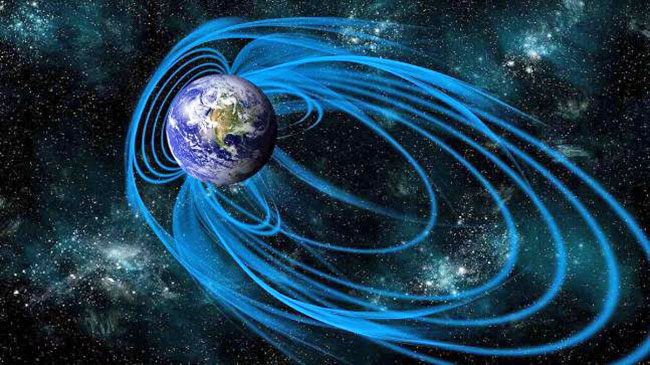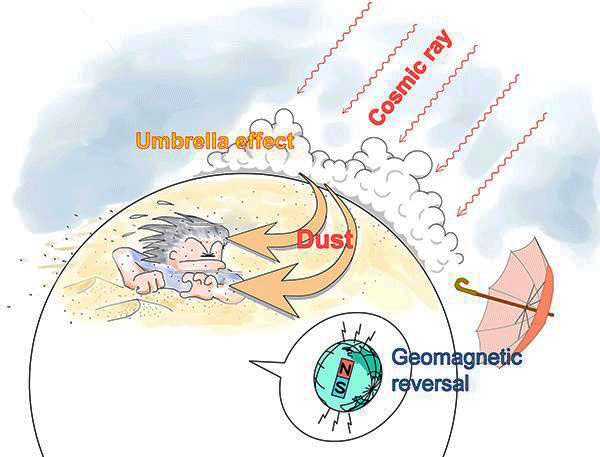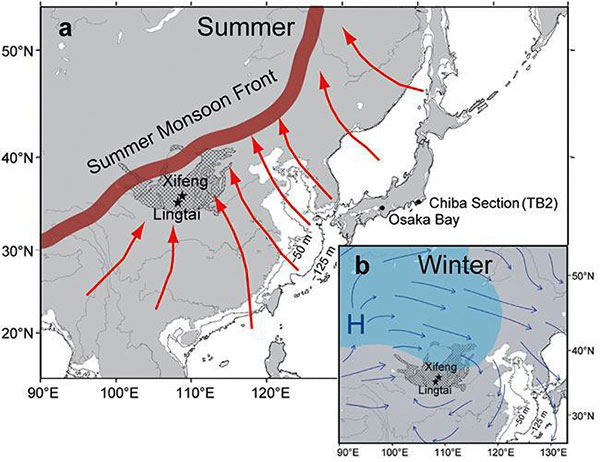|

by Robert Felix
July 08,
2019
from
IceAgeNow Website

Bomb-shell press release from Kobe University confirms what we been
saying for years, that
geomagnetic reversals can trigger
ice ages - perhaps almost instantaneously.
I'm not sure that was the
intent of the press release because it doesn't actually use the
words "ice age," "trigger " or "instantaneous," but that's my take
on it. See if you agree.
With a title that belies its importance, "Winter
monsoons became stronger during geomagnetic reversal,"
the press release (see full release below) explains that galactic
cosmic rays (high-energy particles from space) increased
"dramatically" during the
Matuyama–Brunhes magnetic reversal
of 780,000 years ago.
Such an increase (called
the
Svensmark Effect)
could induce more low cloud formation and influence the Earth's
climate via the umbrella effect.

Credit: Kobe University
That increase in
galactic cosmic rays came about,
the press release explains, because the Earth's magnetic-field
strength plummeted to less than 25 percent of today's.
In-as-much as our
magnetic field shields us from cosmic rays, and in-as-much as
geomagnetic field strength is now declining rapidly (5
percent per decade), and in-as-much as we may be headed
for a reversal right now (here),
this discovery concerns us (here).
As mentioned earlier, the press release doesn't actually use the
words "ice age."
What it does say,
however, is that geomagnetic reversals correlate with sea-level
changes...
What causes sea-level changes? Sea levels decline when water
accumulates on land as ice, forming giant ice sheets sometimes more
than a mile thick. Then, when the ice melts, sea levels rise once
again.
Changes in sea level
therefore imply glaciation. (Sea levels stood at least 400 feet
lower than today during the last period of increased glaciation.)
Just to be fair, even though the press release doesn't mention it,
the underlying paper does mention both glaciation and iceberg
discharge. Kind of hard to get iceberg discharge unless there's some
glaciation going on.
As far as we are concerned, this is enough by itself to show that
geomagnetic reversals correlate with ice ages.
Even more
worrisome to me
Even more worrisome, though, is the following statement almost
buried toward the end of the press release:
"Added to other
phenomena during the geomagnetic reversal - evidence of an
annual average temperature drop of 2-3 degrees Celsius."
Let that sink in for a
moment...
An annual average
temperature drop of 2-3 degrees Celsius.
Do they really mean that average temperature dropped by 2-3ºC every
single year? I'm not sure they do. I may be interpreting it
incorrectly, but if that is indeed what they mean then we could be
in for a very rough ride.
Many people think it takes hundreds, if not thousands of years to
descend into an ice age.
But as warn in Not by
Fire but by Ice, ice core studies show that our planet has
sometimes switched from periods of warmth such today's - such as
today's! - into full-fledged glaciation in less than 20 years.
If average temperature should begin falling by 2-3ºC per year, we
could descend into an ice age so rapidly that we'd have no time to
prepare.
How rapidly?
Do the math.
According to this report,
the earth's average temperature during an ice age is about 12ºF
colder than today.
During the Ice Age,
the Earth's average temperature was about 12 degrees Fahrenheit
colder than it is today.
That was enough to
keep snow from melting during the summers in northern regions.
As snow fell on snow, thick sheets of ice called glaciers
formed.
Source
A research shows that the
tropics and subtropics were only 4 degrees colder than today during
the last major glaciation, while the equatorial rain-forest belt
remained much the same as today (Not
by Fire but by Ice - last page of Chapter 11.)
Whatever the number, let's allow even more leeway. Instead of
calculating a drop of 2-3ºC per year, let's plug in a decline of
"only" 1 degree Fahrenheit per year.
That would mean that our planet could plunge from today's warmth
into full-fledged glaciation in a mere 12 years.
Does anyone honestly
think our civilization, any civilization, could survive such a
catastrophe?
How about surviving without the benefit of (so-called) fossil
fuels?
Additional Information
Winter monsoons became stronger
during...
Geomagnetic Reversal
-
Revealing the impact of cosmic rays on the Earth's climate
-
by Kobe University
July 03, 2019
from
ScienceDaily Website

New evidence suggests that high-energy particles from space
known as galactic cosmic rays affect the Earth's climate by
increasing cloud cover, causing an "umbrella effect".
When galactic cosmic rays increased during the Earth's last
geomagnetic reversal transition 780,000 years ago, the umbrella
effect of low-cloud cover led to high atmospheric pressure in
Siberia, causing the East Asian winter monsoon to become
stronger.
This is evidence that
galactic cosmic rays influence changes in the Earth's climate.
The findings were
made by a research team led by Professor Masayuki Hyodo
(Research Center for Inland Seas, Kobe University) and published
on June 28 in the online edition of Scientific Reports.
The Svensmark Effect is a hypothesis that galactic cosmic
rays induce low cloud formation and influence the Earth's
climate.
Tests based on recent
meteorological observation data only show minute changes in the
amounts of galactic cosmic rays and cloud cover, making it hard
to prove this theory.
However, during the
last geomagnetic reversal transition, when the amount of
galactic cosmic rays increased dramatically, there was also a
large increase in cloud cover, so it should be possible to
detect the impact of cosmic rays on climate at a higher
sensitivity.
In the Chinese Loess Plateau, just south of the Gobi Desert near
the border of Mongolia, dust has been transported for 2.6
million years to form loess layers - sediment created by the
accumulation of wind-blown silt - that can reach up to 200
meters in thickness.
If the wind gets
stronger, the coarse particles are carried further, and larger
amounts are transported.
Focusing on this
phenomenon, the research team proposed that winter monsoons
became stronger under the umbrella effect of increased
cloud cover during the geomagnetic reversal.
They investigated
changes in particle size and accumulation speed of loess layer
dust in two Loess Plateau locations.
In both locations, for about 5000 years during the geomagnetic
reversal 780,000 years ago, they discovered evidence of stronger
winter monsoons: particles became coarser, and accumulation
speeds were up to > 3 times faster.
These strong winter
monsoons coincide with the period during the geomagnetic
reversal when the Earth's magnetic strength fell to less than ¼,
and galactic cosmic rays increased by over 50%.
This suggests that
the increase in cosmic rays was accompanied by an increase in
low-cloud cover, the umbrella effect of the clouds cooled the
continent, and Siberian high atmospheric pressure became
stronger.
Added to other
phenomena during the geomagnetic reversal - evidence of an
annual average temperature drop of 2-3 degrees Celsius, and an
increase in annual temperature ranges from the sediment in Osaka
Bay - this new discovery about winter monsoons provides further
proof that the climate changes are caused by the cloud umbrella
effect.
"The
Intergovernmental Panel on Climate Change (IPCC) has
discussed the impact of cloud cover on climate in their
evaluations, but this phenomenon has never been considered
in climate predictions due to the insufficient physical
understanding of it", comments Professor Hyodo.
"This study
provides an opportunity to rethink the impact of clouds on
climate.
When galactic
cosmic rays increase, so do low clouds, and when cosmic rays
decrease clouds do as well, so climate warming may be caused
by an opposite-umbrella effect.
The umbrella
effect caused by galactic cosmic rays is important when
thinking about current global warming as well as the warm
period of the medieval era."
Journal Reference
| 



